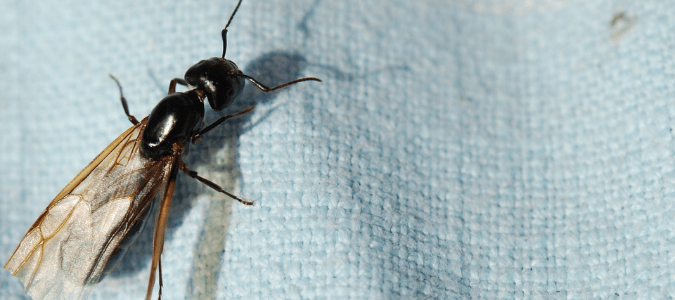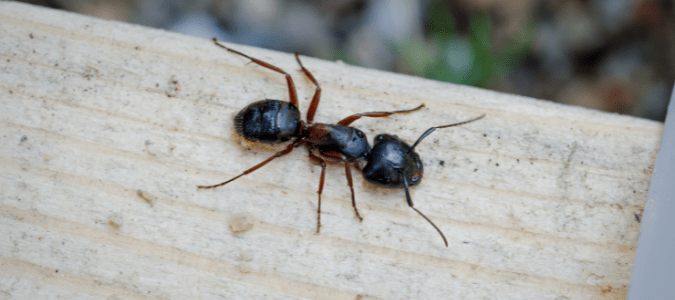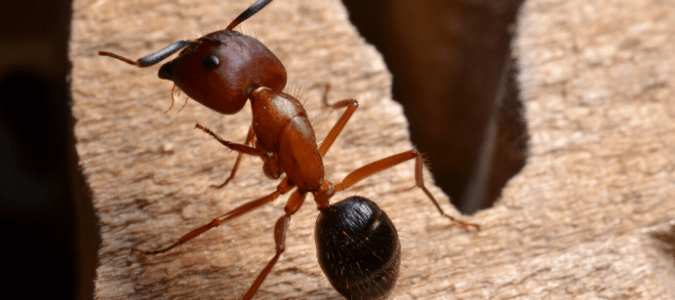Carpenter ants do not always fly, but when you spot a winged version of one of these creatures, it could mean trouble. These pests can damage your home by chewing through a variety of wooden structures.
As adults, carpenter ants are about a quarter of an inch to three-fourths of an inch in length. Their segmented bodies are typically black, reddish or multicolored, and they have hair on the tip of their abdomen. Adult worker ants are usually wingless, but reproductive carpenter ants have wings and can look a lot like flying termites. These winged reproductive adults are also called “swarmers.” If you see these pests around your property it typically means there is a carpenter ant nest nearby. Unfortunately, this might also mean that these pests are damaging the structural integrity of your home.
Carpenter ants swarm when they are mating, which typically happens in the spring or early summer. The flying males and females emerge to find a mate. After this nuptial flight, the males die off and the female ants look for places like rotted out trees, gaps in insulation or wet, dead or weakened wood, landscaping timers or beams to build their nests.
Carpenter ants seek out places with high relative humidity when they are looking for a spot for their nest. This means specific areas of your home might be more vulnerable to carpenter ants. Some of the locations in houses where they most commonly build nests include:
- insulation in the walls, attic or crawl space;
- water-damaged wood around window or door frames, near clogged gutters or along flashing;
- the space between the porch’s roof and ceiling or the porch columns, posts or flooring;
- spaces with pre-existing cavities, such as hollow wooden doors, curtain or shower rods or between beams or studs;
- spots around water leaks from plumbing in the bathroom or kitchen;
- crevices between pieces of wood in tongue-and-groove construction;
- spaces around moist areas like showers, bathtubs or hot tubs;
- wooden parts of the structure that touch soil, such as siding, porch supports or stairs and
- poorly ventilated areas like under the porch or in the cellar, attic or crawl space.
The Carpenter Ant Life Cycle
Once the females find the perfect spot for a nest, they then lay their eggs and tend them in the nest. The carpenter ant’s development process can occur over the course of four weeks up to two months. The eggs turn into grub-like larvae and then develop into tan or cream-colored pupae before growing into the big black ants you see around your home, or worker ants. These ants then take care of the nest and provide food for the queen ant and the larvae in their colony.
While carpenter ants build their nests in wood, they do not eat wood. Instead, they forage around at night as far as hundreds of yards away from their nest and look for a wide variety of foods to bring back to the colony. Carpenter ants eat a range of plant and animal products, including insects, fresh fruit, sugar, fat, plant juices, jelly and meat.
Over time, each colony can grow to house thousands of ants and produce hundreds of winged reproductive adults each year. These flying reproductives then begin the carpenter ant life cycle all over again. If you see flying carpenter ants around your home or yard, the best way to deal with these pests is to contact a pest control professional.
Once these pests start flying around, it is a sign that there is an infestation nearby. Unfortunately, this could mean you have thousands of ants on your property. Instead of trying to deal with this all on your own, you can hire an expert ant control specialist who can take care of everything for you. These professionals can help you figure out where these pests are coming from. Then, they can treat the pest problem effectively.
Where Do Carpenter Ants Come From?
Carpenter ants typically nest in damaged or rotted wood. This is why if you find a carpenter ant infestation in your home, it could be a sign that your house might have another problem like a water leak.
Unlike termites, carpenter ants do not eat wood, but they can build their homes and further destroy wood that termites have already damaged. These ants are also attracted to wood that has been weakened by other conditions. Many species of carpenter ants are drawn to moisture. If you live in an area with high humidity then this could make your home more vulnerable to these pests.
In any climate, some other factors might also attract carpenter ants to your home or yard. For example, carpenter ants are likely to seek out any kind of wood debris on your property, including piles of firewood, abandoned logs or tree stumps. You can help make your yard less attractive to these pests by clearing away wood debris and keeping your firewood pile far away from your house.
You can also take some preventative measures inside your home to help reduce the chance of a carpenter ant infestation. For example, if you have had a termite infestation on your property, it is wise to replace any damaged wood. Otherwise, carpenter ants might use the weakened wood as their next home.
It is also smart to promptly fix leaks and areas with poor ventilation. Any buildup of moisture, such as in places around a roof leak, areas with poor drainage or spots near a leaking faucet, can attract carpenter ants.
In addition, it is also important to regularly inspect your house for possible infestations. Carpenter ants can use the smallest opening to get into your home. Some of the areas where they can enter a house include:
- gaps around ventilation in the attic;
- places where tree branches, vines or shrub branches touch the structure;
- crevices around windows, the chimney or air conditioning or heating ducts;
- holes around where utility lines connect to your house and
- cracks in the foundation.
Additionally, it is wise to know what kind of pest you are dealing with. To the untrained eye, flying carpenter ants can look a lot like termites. Unfortunately, treatments for termites usually will not help control carpenter ants.
If you think you might have a carpenter ant infestation, the best thing to do is to contact a pest control specialist. These professionals have the training, experience and specialized tools to figure out what kind of pest is on your property. They can also treat any type of ant problem, so your life can go back to normal as soon as possible.
What Does Carpenter Ant Damage Look Like?
If you see flying carpenter ants around your property, then it could be a sign that you have an infestation. However, sometimes, you might see the damage these pests have caused long before you see the ants themselves.
Carpenter ant damage usually appears in or along wooden areas of your home or property. One thing you can look for are tiny holes on the surface of the wood. Additionally, if you find a cone-shaped pile of sawdust-like or shredded debris (also called “frass piles”) near one of these holes, it could be a sign that you have a carpenter ant infestation.
These ants build their nests in wet, rotted or damaged wood by cleaning out spaces in the wood to create smooth tunnels or cavities (also called galleries). They remove wood fragments and dead insects from the cavity and place them outside the nest through a tiny hole, also called a “kick-hole.”
Carpenter ants sometimes hide these frass piles in out of sight areas, such as behind walls or inside trees. However, in the outdoor areas of your property, you might be able to find carpenter ant damage near old trees, log piles, tree stumps or dying shrubbery. Inside a home or around the perimeter of the structure, some of the places where you are more likely to find this kind of damage include:
- along the edges of the roof;
- areas with poor ventilation or high humidity, such as bathrooms, laundry rooms, crawl spaces, cellars or attics;
- near wooden porch columns or floors or
- spots where fences, utility lines, vines or tree limbs touch the house.
If you find any of these signs of destruction, it might mean that you have a carpenter ant infestation and that they could be contributing to structural damage to your home. That is why it is essential to reach out to a pest control professional as soon as possible. They can help determine whether you have found carpenter ant damage, termite damage or something else. Plus, they can take care of everything needed to treat the pest infestation efficiently and effectively, so you do not have to worry.
ABC Can Treat the Ants on Your Property
Having destructive pests on your property, like carpenter ants, can be alarming. ABC Home & Commercial Services can create a thorough pest treatment plan, so you can feel at ease. We can also help with identifying the pest on your property, so you know exactly what you’re dealing with.


